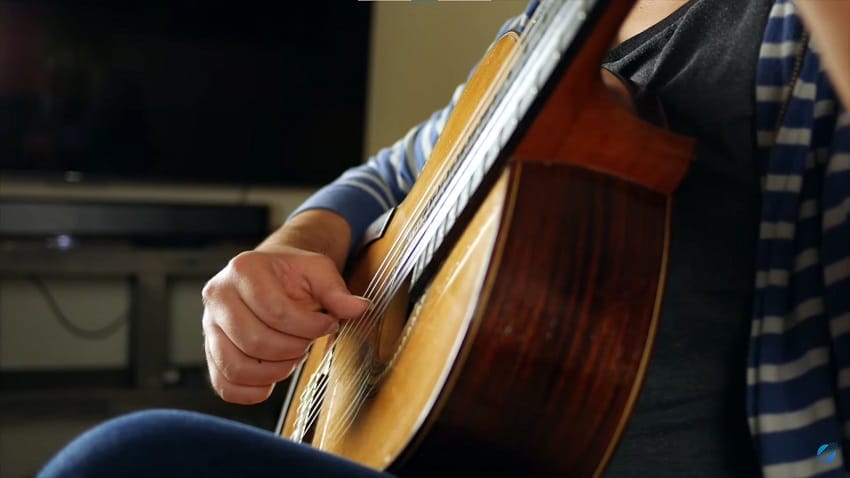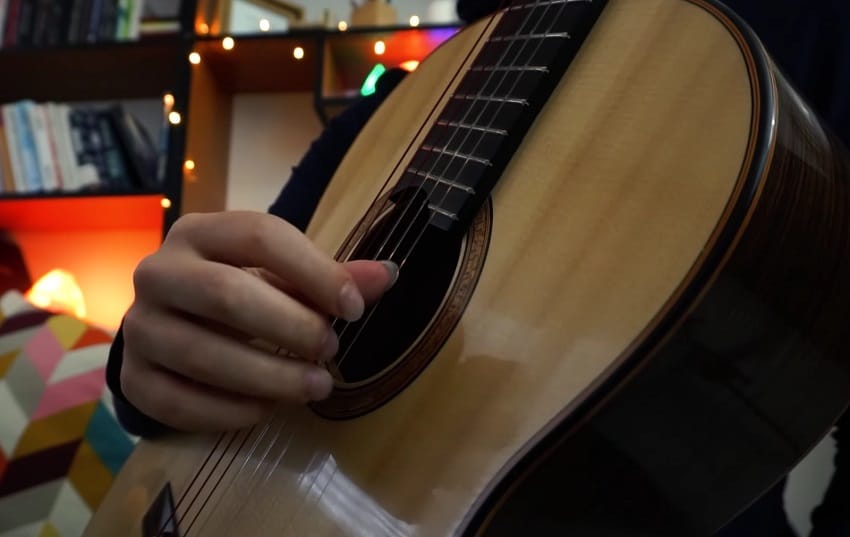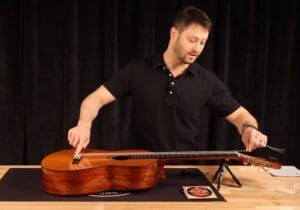Table of Contents
The classical guitar tremolo technique is expressive. It produces a sustained, shimmering note with rapid volume changes. This creates a pulsating effect while keeping the same pitch. To play it, start with a bass note using the thumb.
Then, play three repeated higher notes. Use the ring (a), middle (m), and index fingers (i) for the higher notes. To make a mesmerizing tremolo, follow these basic principles.
Along with tremolos, check out the library of classical guitar techniques!

Basic Principles of Classical Guitar Tremolo Technique
Tremolo is a technique for creating the illusion of a sustained note on the classical guitar. First, ensure that you have a relaxed and balanced right-hand position with a slightly arched wrist aligned with the forearm. Since the thumb typically provides the background accompaniment in a tremolo, it should be played softly. The thumb lightly rests on the guitar’s neck while the index, middle, and ring fingers play the tremolo, and the pinky finger provides stability by resting on the soundboard.
Choosing Fingers
Choosing the appropriate fingers is a must. Use the “a,” “m,” and “i” fingers for tremolo. The “a” finger plucks the bass note, while the “m” and “i” fingers alternate for the treble melody, enabling a balanced and controlled sound.
Maintaining A Steady Rhythm
Maintaining a steady rhythm is crucial for a smooth and captivating tremolo. The alternating fingers should follow a consistent pattern, with the “a” finger providing a stable and rhythmic foundation.
Achieving a smooth tremolo requires precise hand coordination and independent finger movement, especially developing strength in the ring finger alongside p, i, and m.
The interplay between bass and upper lines adds to its allure, making the tremolo a beloved technique in classical guitar performances. Practicing with a metronome can be helpful in developing a precise and even tempo. Gradually increasing the speed while maintaining accuracy is the key to mastering the tremolo rhythm.
Rest Strokes and Free Strokes
Choose between rest and free strokes for different tone characteristics. By allowing the finger to rest against the neighboring string after plucking, rest strokes produce a full and resonant tone. By moving the finger away from the surface of the guitar, free strokes produce a lighter and softer tone.
Developing Finger Independence
To improve finger independence on the classical guitar, various exercises can be practiced. One such exercise involves placing all four fingers of the left hand on four adjacent frets, such as the 1st, 2nd, 3rd, and 4th frets on the 6th string.
Then, each finger is lifted one at a time while the other fingers remain on their respective frets. This exercise helps develop strength and control in each finger, making them more independent and responsive during playing. The tremolo should be smooth and fluid, like water or a small stream. Don’t play too heavy, and don’t play each note so individually.

Another exercise involves playing chromatic scales with each finger individually on each string. This exercise enhances finger agility and dexterity, as each finger is required to move independently without affecting the others.
As finger independence improves, it’s essential to work on tempo progression to ensure consistent and accurate playing. Start with slow tempos and gradually increase the speed as comfort and control are gained.
Metronomes are valuable tools for tracking progress and maintaining a steady tempo while practicing finger independence exercises.
Beginner’s Tremolo Lesson
Let’s break down this creative technique into three simple steps, making it accessible to all guitar enthusiasts.
Step 1: Learn the Chord Progression
To start, it’s essential to learn a chord progression that you’ll apply the tremolo technique to. Remember, Tremolo isn’t just for classical music. It can add a unique flavor to your playing style, whether you’re into classical, Spanish, or modern music.
Step 2: Alternate Chords with 1st String
Once you’ve got the hang of your chosen chord progression, the next step is to alternate between these chords while emphasizing the 1st string. This alternating motion will set the foundation for your tremolo technique.
Step 3: Practice the Simplified Three-Note Tremolo
Now, let’s dive into the heart of tremolo. We’ll simplify it initially by focusing on just three notes. Use your thumb to play a bass note and your index (i), middle (m), and ring (a) fingers to create the pulsating effect on the 1st string. This repetitive pattern is the essence of tremolo.
By practicing the tremolo technique, you’ll gradually improve your tremolo technique and incorporate it fluently into your acoustic guitar playing.
As you gain confidence and skill, you can advance to the ultimate tremolo technique. This involves refining your control and speed, allowing you to produce a sustained, shimmering note with rapid volume changes while maintaining the same pitch. This mesmerizing tremolo will enhance your guitar-playing repertoire.

Playing a tremolo with tiny finger movements
Playing a tremolo with small finger movements is a technique that requires precision and control. Here are the steps to achieve this skill, based on the provided source:
Practice on the Second String
Focus your tremolo practice on the second string. This positioning places the first string in front of your fingers and the third string behind them. Practicing on the second string forces you to use smaller finger motions to avoid hitting adjacent strings. While it may be more challenging initially, it trains your fingers to move efficiently.
Use Pluck-Release Strokes
Embrace the pluck-release stroke technique, which involves the following steps:
- Line up your “a,” “m,” and “i” fingers in front of the second string as low above the string as possible.
- Pluck the second string with your “a” finger, using muscle power or tension. Do not follow through; limit the travel distance to slightly above the third string.
- Immediately relax your “a” finger, releasing the tension. Allow gravity to pull it back to its starting position in front of the second string.
- Keep your “i” and “m” fingers stationary during this process.
- Repeat this process with your “m” and “i” fingers, keeping the same principles of minimal follow-through and releasing tension. Always return each finger to its position in front of the second string.
By practicing on the second string and using the pluck-release technique, you can train your fingers to make small, controlled movements. This approach improves accuracy, ensures you hit the correct string, and optimizes tone quality. Remember to be patient and persistent in your practice to master the art of playing a tremolo with minimal finger movements.
Check out the classical guitar Legato techniques here.
Some Tremolo Exercises
It makes sense that during tremolo exercises, we would concentrate on rhythmic evenness and rapidity. However, make sure to also listen for uneven tone quality and superfluous fingernail and thumbnail noises. Here are some tremolo exercises for guitar that you can practice to improve your technique
Exercise 1

Exercise 2

Exercise 3

Fingernails or No fingernails?
Fingernails have a pronounced effect on the quality of guitar tremolo, influencing not only the sound but also the precision of the technique. When a player uses their nails, they can achieve a distinct contact point that produces a clear, bright sound with each pluck.
However, the rapid succession of notes in tremolo makes maintaining the ideal flesh/nail contact challenging. Deviations can result in unwanted clicking noises or an inconsistent tone as the fingernails strike the strings.
The player’s awareness and control over their finger movements are essential in minimizing these extraneous noises. A consistent and accurate strike on the strings – hitting the so-called ‘sweet spot’ – is vital for a smooth and even-sounding tremolo.
While practicing tremolo, it’s important not only to focus on speed and rhythmic precision but also to listen attentively for any nail noise and strive for a uniform tone across all notes.
The use of nails is a personal preference and is often debated among guitarists. Those in favor of using nails cite the superior tone and volume they can produce. On the other hand, players without nails avoid the hassle of nail maintenance and enjoy the freedom to employ certain techniques that are not conducive to long nails, such as some tapping techniques on electric guitar.
Ultimately, whether or not to use nails comes down to individual choice and the specific sound and style a guitarist is aiming to achieve. Both approaches are valid and can produce excellent results when executed with skill and attention to detail.
Famous Classical Guitar Tremolo Pieces
Francisco Tárrega, the renowned Spanish composer and guitarist, left a lasting impact on classical guitar music with his influential works. His “Study in B minor” challenges finger independence and classical guitar tremolo technique with intricate movements to achieve a flowing melody and rhythmic bass counterpoint.
“Una Limosna Por el Amor de Dios” by Agustin Barrios Mangoré
“Una Limosna Por el Amor de Dios” by Agustin Barrios Mangoré is one of the most famous and is also considered to be one of the toughest pieces of classical guitar to learn. The piece is in 6/8 time and in the key of A minor. It’s a slow, poetic composition with a lovely melody. The song is entirely played in tremolo, a technique in which the right hand selects the strings very swiftly in a continuous motion.
“Recuerdos de la Alhambra” by Francisco Tárrega
“Recuerdos de la Alhambra” is an iconic piece by Tárrega, beloved among classical guitar enthusiasts for its enchanting melody and intricate tremolo patterns. Check out the video of Brandon Acker performing Francisco Tarrega’s magnificent Recuerdos de la Alhambra.
The version of “Recuerdos de la Alhambra” by Andrés Segovia is another piece you can check. Great musicians like John Williams and Andrés Segovia have a lot to teach us.
“Capricho Árabe” by Francisco Tárrega
Let’s not forget about “Capricho Árabe.” It’s one of the most well-known and adored works in the classical guitar repertoire. In “Capricho Árabe,” Tárrega showcases finger independence and tremolo skills with a masterful blend of melodic lines and intricate passages. Though originally composed for piano, “Asturias” has become a popular classical guitar piece, demanding exceptional finger independence and precision to convey its passionate and virtuosic character.
The difference between flamenco and classical tremolo
Flamenco and classical tremolo are both techniques used to create a rapid, sustained sound on the guitar. However, there are some key differences between the two techniques.
Flamenco tremolo is characterized by its use of alternating bass notes and a fast, rhythmic pattern. The bass notes are typically played with the thumb, while the treble notes are played with the index and middle fingers. The pattern is often syncopated, with accents on the offbeats.
Classical tremolo is generally considered to be a more refined and delicate technique than flamenco tremolo. It is typically played with a slower tempo and a more even pattern. The bass notes are often played with the thumb, while the treble notes are played with the index, middle, and ring fingers.
FAQs
The amount of time it takes to learn tremolo on classical guitar varies from person to person. Some students may be able to master the basic technique within a few weeks, while others may need months or even years of practice.
There are a number of factors that can affect how quickly you learn tremolo, including your natural talent, the amount of time you practice, and the quality of your instruction. If you are serious about learning tremolo, it is important to find a qualified guitar teacher who can help you develop the proper technique.
There are a few things you can do to increase your tremolo speed:
Practice slowly and accurately: It is important to develop a solid foundation in the basic tremolo technique before you start trying to play fast. Once you can play tremolo accurately at a slow tempo, you can gradually start to increase the speed.
Use a metronome: A metronome can help you to maintain a consistent rhythm as you increase the speed of your tremolo. Start by setting the metronome to a slow tempo and gradually increase the tempo as you become more comfortable.
Relax your hand and wrist: It is important to keep your hand and wrist relaxed when playing tremolo. This will help you to avoid tension and fatigue, which can lead to mistakes.
Practice regularly: The more you practice, the better your tremolo will become. Make sure to practice tremolo for at least 15 minutes each day.
The typical tempo for a tremolo is between 120 and 160 beats per minute (BPM). However, the actual tempo can vary depending on the piece of music and the player’s personal preference.
Some players may choose to play tremolo at a slower tempo to create a more lyrical and expressive sound. Others may choose to play tremolo at a faster tempo to create a more exciting and dynamic sound.
Ultimately, the best way to determine the ideal tempo for your tremolo is to experiment and find what sounds best to you.
- Budget Classical Guitars Under $700 - February 15, 2025
- How To Set Up A 12-String Guitar Perfectly - September 8, 2023
- Vibrato Techniques: A Comprehensive Guide - September 6, 2023









